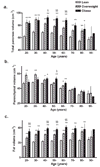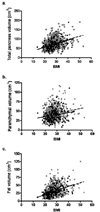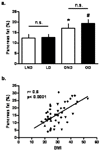Pancreas volumes in humans from birth to age one hundred taking into account sex, obesity, and presence of type-2 diabetes
- PMID: 17879305
- PMCID: PMC2680737
- DOI: 10.1002/ca.20543
Pancreas volumes in humans from birth to age one hundred taking into account sex, obesity, and presence of type-2 diabetes
Abstract
Our aims were (1) by computed tomography (CT) to establish a population database for pancreas volume (parenchyma and fat) from birth to age 100 years, (2) in adults, to establish the impact of gender, obesity, and the presence or absence of type-2 diabetes on pancreatic volume (parenchyma and fat), and (3) to confirm the latter histologically from pancreatic tissue obtained at autopsy with a particular emphasis on whether pancreatic fat is increased in type-2 diabetes. We measured pancreas volume in 135 children and 1,886 adults (1,721 nondiabetic and 165 with type-2 diabetes) with no history of pancreas disease who had undergone abdominal CT scan between 2003 and 2006. Pancreas volume was computed from the contour of the pancreas on each CT image. In addition to total pancreas volume, parenchymal volume, fat volume, and fat/parenchyma ratio (F/P ratio) were determined by CT density. We also quantified pancreatic fat in autopsy tissue of 47 adults (24 nondiabetic and 23 with type-2 diabetes). During childhood and adolescence, the volumes of total pancreas, pancreatic parenchyma, and fat increase linearly with age. From age 20-60 years, pancreas volume reaches a plateau (72.4 +/- 25.8 cm(3) total; 44.5 +/- 16.5 cm(3) parenchyma) and then declines thereafter. In adults, total ( approximately 32%), parenchymal ( approximately 13%), and fat ( approximately 68%) volumes increase with obesity. Pancreatic fat content also increases with aging but is not further increased in type-2 diabetes. We provide lifelong population data for total pancreatic, parenchymal, and fat volumes in humans. Although pancreatic fat increases with aging and obesity, it is not increased in type-2 diabetes.
2007 Wiley-Liss, Inc
Figures






References
-
- Altman PL, Dittmer DS. Growth-including reproduction and morphological development. Washington, DC: Federation of American Societies for Experimental Biology; 1962.
-
- Altobelli E, Blasetti A, Verrotti A, Di Giandomenico V, Bonomo L, Chiarelli F. Size of pancreas in children and adolescents with type 1 (insulin-dependent) diabetes. J Clin Ultrasound. 1998;26:391–395. - PubMed
-
- Alzaid A, Aideyan O, Nawaz S. The size of the pancreas in diabetes mellitus. Diabet Med. 1993;10:759–763. - PubMed
-
- Assimacopoulos-Jeannet F. Fat storage in pancreas and in insulin-sensitive tissues in pathogenesis of type 2 diabetes. Int J Obes Relat Metab Disord. 2004;28(Suppl 4):S53–S57. - PubMed
-
- Butler AE, Janson J, Bonner-Weir S, Ritzel R, Rizza RA, Butler PC. β-Cell deficit and increased β-cell apoptosis in humans with type 2 diabetes. Diabetes. 2003;52:102–110. - PubMed
Publication types
MeSH terms
Grants and funding
LinkOut - more resources
Full Text Sources
Other Literature Sources
Medical

